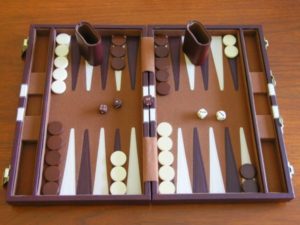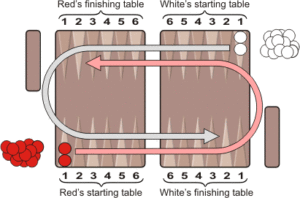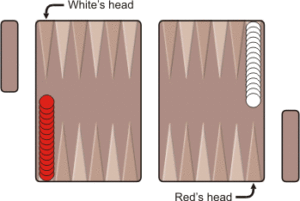Tawula – Backgammon Variant
 Setup: Each player starts with 2 checkers on the rightmost point of the far side of the board, at diagonally opposite corners from each other, and 13 checkers off the board. The players move in the same direction, counterclockwise, around the board.
Setup: Each player starts with 2 checkers on the rightmost point of the far side of the board, at diagonally opposite corners from each other, and 13 checkers off the board. The players move in the same direction, counterclockwise, around the board.
Object: The object of the game is to move all of your checkers around the board to your finishing table, and then bear them off.
To start: Each player rolls one die. The player who rolls the higher number goes first and uses the numbers rolled for his first turn.
Entering checkers: A player may not move his first two checkers (the ones that are initially on the board) until all of his other checkers have been entered onto the board. You enter a checker by placing it on a point in the starting table corresponding to a number rolled. For example, if you roll 6-3, then you may enter a checker onto the six-point or three-point. However, you may not enter a checker onto a point occupied by one or more of your own checkers, or onto a point occupied by two or more opposing checkers.
 After you have entered a checker, you have the option of using the other number(s) rolled either to enter more checkers or to move the checkers already entered.
After you have entered a checker, you have the option of using the other number(s) rolled either to enter more checkers or to move the checkers already entered.
Movement: The roll of the dice indicates how many points, or pips, the player is to move his checkers. The following rules apply:
- A checker may be moved only to an open point, one that is not occupied by two or more opposing checkers.
- The numbers on the two dice constitute separate moves. For example, if a player rolls 5 and 3, he may move one checker five spaces to an open point and another checker three spaces to an open point, or he may move the one checker a total of eight spaces to an open point, but only if the intermediate point (either three or five spaces from the starting point) is also open.
- Doubles are played twice. For example, a roll of 6-6 means the player has four sixes to use.
- You must use both numbers of a roll if possible, or all four numbers in the case of doubles.
 Hitting: A checker sitting alone on a point is called a blot. If an opposing checker lands on a blot, the blot is hit and placed on the bar.
Hitting: A checker sitting alone on a point is called a blot. If an opposing checker lands on a blot, the blot is hit and placed on the bar.
If a blot is hit in the opponent’s starting table, a point in that table must be left open so that reentry is possible, but this does not apply if the blot was hit elsewhere on the board.
Entering from the bar: Any time you have one or more checkers on the bar, your first obligation is to reenter those checker(s) into your starting table. You enter a checker by moving it to an open point corresponding to one of the numbers on the rolled dice. If you are able to enter some but not all of your checkers, you must enter as many as you can then give up the remainder of your turn.
Restrictions on closing points: You are not allowed to pile more than one checker on a point on the opponent’s side of the board with one exception: The leftmost point on the opponent’s side of the board is called your “head” and you may pile as many checkers as you want onto that point.
This makes entering checkers much more difficult than in regular backgammon because now your own checkers create blocks in addition to any closed points created by your opponent.
Bearing Off: Once you have moved all fifteen of your checkers into your finishing table, you may begin bearing off. You bear off by rolling a number that corresponds to the point on which the checker resides, and then removing that checker from the board.
If there is no checker on the point indicated by the roll, then you must make a legal move using a checker on a higher-numbered point. If there are no checkers on higher-numbered points, you must remove a checker from the highest point that has a checker.
Scoring: The first player to bear off all fifteen checkers wins the game. If a player has borne off one checker and has all his other checkers ready to be borne off, and the opponent has one checker on the bar and all his other checkers ready to be borne off, then the first player wins capote, counting seven games.
There is no doubling in this game.